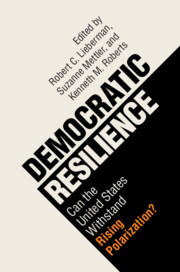Book contents
- Democratic Resilience
- Democratic Resilience
- Copyright page
- Dedication
- Contents
- Figures
- Tables
- Contributors
- Acknowledgments
- Part I Why Might Polarization Harm Democracy?
- Part II Political Institutions in Polarized Times
- Part III Social Polarization and Partisanship
- Part IV Vicious Circles? The Relationship between Polarized Behavior and Institutions
- Part V Can Political Action Save Democracy in Polarized Times?
- 14 Elections, Polarization, and Democratic Resilience
- 15 Citizen Organizing and Partisan Polarization from the Tea Party to the Anti-Trump Resistance
- Index
15 - Citizen Organizing and Partisan Polarization from the Tea Party to the Anti-Trump Resistance
from Part V - Can Political Action Save Democracy in Polarized Times?
Published online by Cambridge University Press: 20 November 2021
- Democratic Resilience
- Democratic Resilience
- Copyright page
- Dedication
- Contents
- Figures
- Tables
- Contributors
- Acknowledgments
- Part I Why Might Polarization Harm Democracy?
- Part II Political Institutions in Polarized Times
- Part III Social Polarization and Partisanship
- Part IV Vicious Circles? The Relationship between Polarized Behavior and Institutions
- Part V Can Political Action Save Democracy in Polarized Times?
- 14 Elections, Polarization, and Democratic Resilience
- 15 Citizen Organizing and Partisan Polarization from the Tea Party to the Anti-Trump Resistance
- Index
Summary
The November 2020 elections delivered a big victory for Democratic presidential challenger Joseph R. Biden along with gains or holds for many Republicans running in congressional and state contests. Reinforced partisan divisions were not, however, the most remarkable aspect of this election. Amid a raging deadly pandemic and sharp economic retraction, about two-thirds of eligible Americans registered their votes by mail or in-person, marking the highest eligible voter turnout in more than a hundred years. Some 74 million voted for Donald Trump, while more than 81 million supported the winner, Joe Biden. This remarkably high voter turnout continued through the early January 2021 Georgia runoffs, where upset victories for Democrats Jon Ossoff and Raphael Warnock delivered control of the US Senate to their party through 2022. A modern US electoral system that has, for decades, exhibited extraordinary slack in voter participation suddenly experienced engaged citizens on both ends of the partisan spectrum, as many more Americans than the usual ideologically attuned elites, interest groups, and party-oriented activists, jumped into a high-stakes, emotionally and morally infused referendum on the meaning and future of US democracy.
Keywords
- Type
- Chapter
- Information
- Democratic ResilienceCan the United States Withstand Rising Polarization?, pp. 369 - 400Publisher: Cambridge University PressPrint publication year: 2021
- 1
- Cited by



